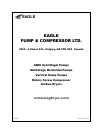
6
b. A high quality turbine type oil with rust and oxidation
inhibitors should be used. Under normal operating
conditions, an oil of 300 SSU viscosity at 100° F.
(approximately SAE 20) should be used. Fill oiler bottle
and replace in oiler housing. Repeat until oil remains
visible in bottle. Do not add oil through the vent or
breather. Optional grease lubricated bearings are lubricated
at the factory and need lubrication only after 2,000
hours of operation, or every 3 months, which ever occurs
first. On pumps supplied with greased–for–life bearings,
no additional lubrication is required for the life of the
bearing.
Oil Mist lubrication of bearings is available on A100–X
frames. This can be supplied at time of order, or field
conversion can be done. Refer to the instructions of the
manufacturer of the Oil Mist System.
c. Priming—Pump and suction piping must be full of liquid
before pump is started. Usually suction supply will be
primed when shutoff valves are opened, if pump is below
suction supply. If suction supply is below pump, priming
by other means, such as a foot valve or ejector, will be
required.
d. Free Rotation—Rotate shaft by hand to make sure it is
free. Drag from packing or seal is normal but, if pump
cannot be rotated by hand or binding or rubbing is noticed,
correct before starting pump.
2. Startup
a. Valves—Be sure suction valve is fully open. Normally,
discharge valve should be at least partially closed for flow
control.
b. Rotation Check—if not already done, uncouple the unit
and jog the motor to check for proper rotation (refer to
Section II–E–2, page 5).
III-B. Operation Checks
Inspect pump carefully and frequently during the first few hours
of operation. If packing runs hot, shut pump down, allow box
to cool, loosen gland if necessary. (Do not loosen gland until
packing has cooled.) Mechanical seal may weep slightly, but
should “run–in” in a few hours. Be sure all auxiliary lines
(cooling, flushing, sealing, etc.) are functioning properly. Check
pump bearings for excessive heating. Bearing housing operating
temperatures vary depending on a wide variety of conditions.
However, normal temperatures should be 120° to 180° F. (49° to
82° C). A change of temperature can indicate a problem, and
operating temperatures outside of the normal range should be
addressed with manufacturer. Check complete unit for excessive
vibration and unusual noises. Do not run pump at greatly
reduced flow because damage can result.
III-C. Shutdown Procedure
Back flow through pump will cause reverse rotation. If backflow
is excessive, and there is a possibility of the pump being turned
on during this period of reverse rotation, then precautions
should be taken to prevent the backflow. This can be done
by installing a check valve in the discharge line, or by closing
a discharge valve immediately prior to shutting down the
pump. NOTE: IT IS NOT RECOMMENDED THAT THE
PUMP RUN LONGER THAN ABSOLUTELY NECESSARY
AGAINST A CLOSED DISCHARGE VALVE.
SECTION IV—PREVENTIVE AND CORRECTIVE MAINTENANCE
IV-A. Lubrication
Oil lubricated units require that oil be visible in the reservoir at
all times. Oil should be changed every 4000 hours of operation.
Grease lubricated units should be regressed every 2000 hours
or 3 month intervals, whichever occurs first. Use a sodium
or lithium grease and fill until grease comes out grease relief
fittings. Follow motor and coupling manufacturers’ lubrication
instructions.
IV-B. Stufng Box
1. Packing Stuffing Box:
Periodically inspect stuffing box to see that there is sufficient
leakage to lubricate the packing and maintain a cool box. Never
restrict the leakage from the packing as this will cause damage
to both packing and shaft sleeve. Draw up gland nuts slowly
and evenly and only while pump is running.
After pump has been in operation for some time and the packing
has been completely “run–in”, a leakage of 40 to 60 drops per
minute of the liquid should be allowed to flow from the stuffing
box at all times for cooling and lubricating the packing and
shaft sleeve.
2. Stuffing Boxes with Mechanical Seal:
Although this type of box requires no attention, a periodic
inspection of the circulating lines will ensure that they do not
become clogged.
IV-C. Vibration
It is good practice to periodically monitor vibration of the
pump. Normally, the vibration level will be well within accepted
standards. Of equal importance is that the vibration level not
increase. If a problem with vibration is encountered, refer to
Trouble Shooting, Section VII.
IV-D. Alignment—Final
Alignment should be checked after unit has reached operating
temperature, following startup. Repeat alignment procedures
outlined in Section II–E. Check alignment again after one week
of operation.
IV-E. Performance
If performance deteriorates, refer to Trouble Shooting, Section
VII.


















